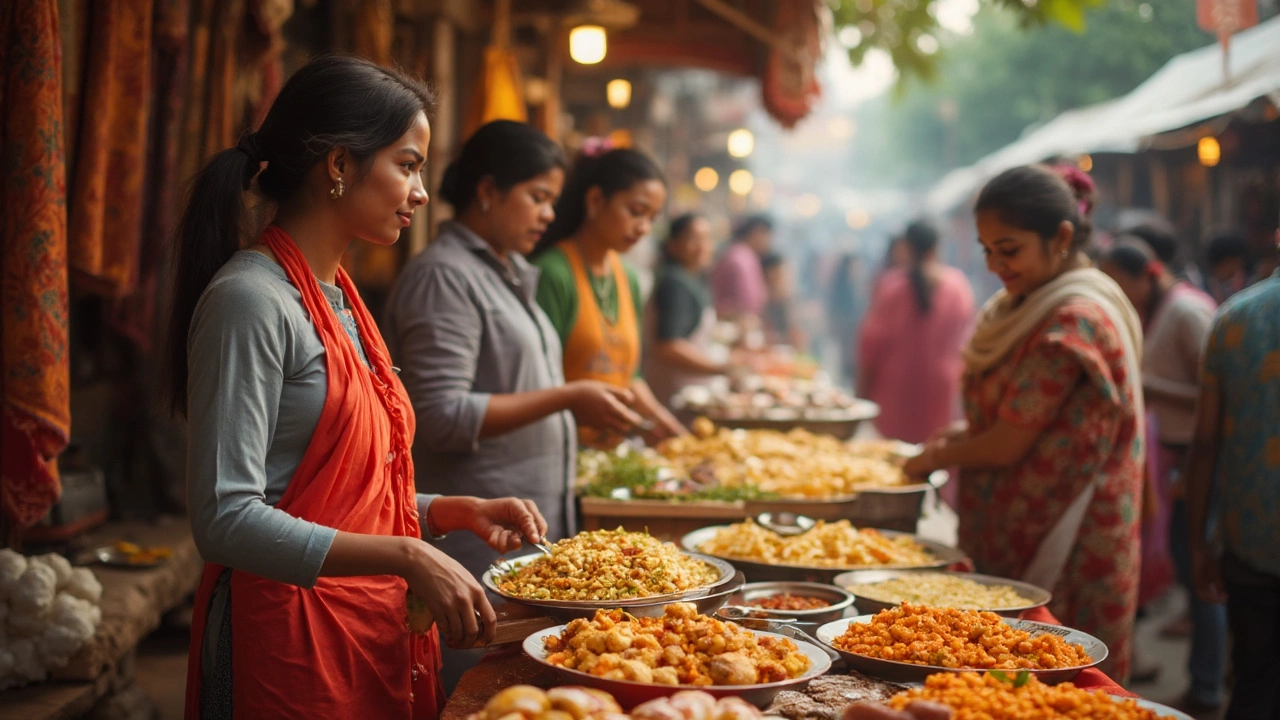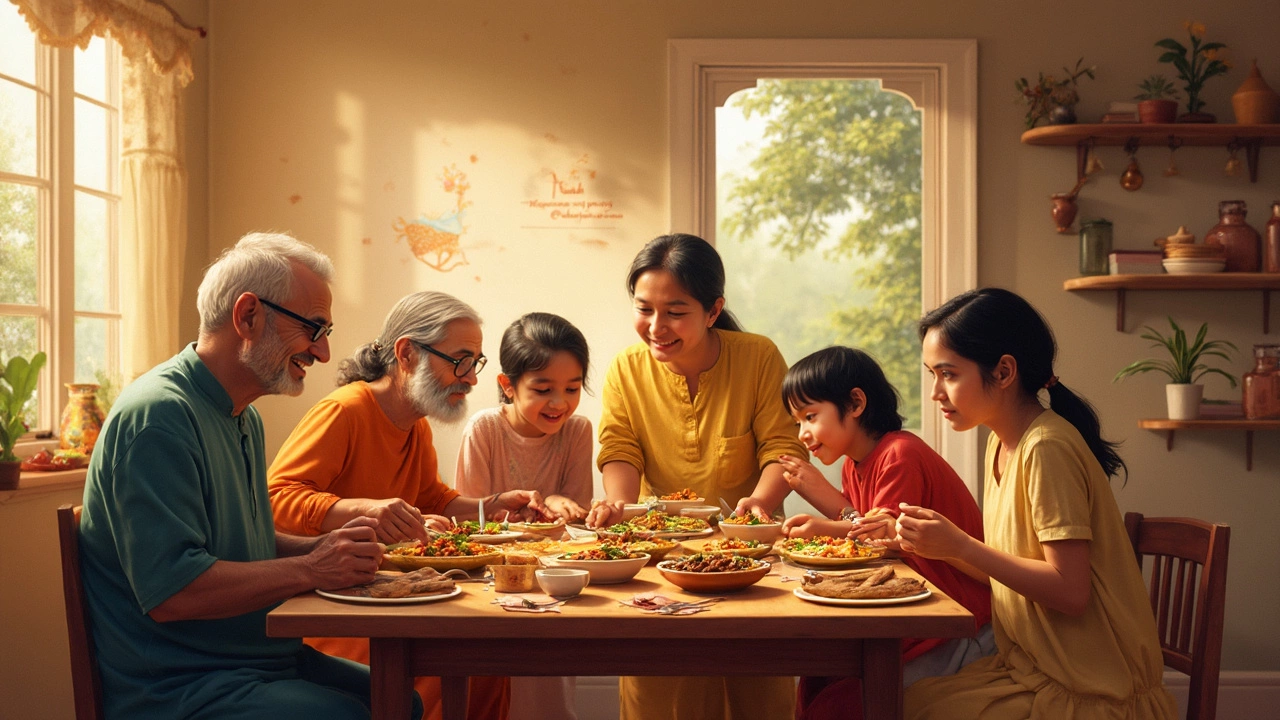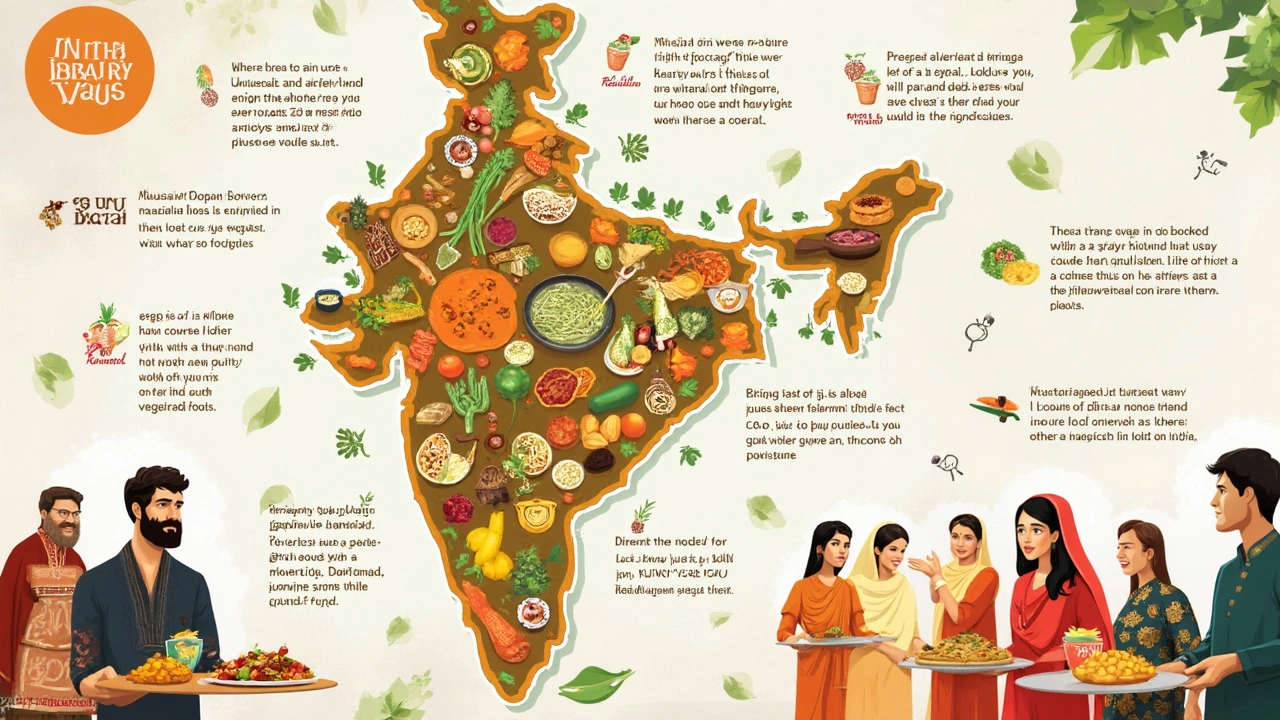Which Country Is 100% Vegetarian? Facts, Myths, and Indian Food Tips
 May, 3 2025
May, 3 2025
The idea of a truly 100% vegetarian country sounds cool, especially if you love plant-based food. But here's the real deal—there isn’t a single country in the world where every single person eats only vegetarian food, not even India.
India gets its reputation because it has the largest number of vegetarians on the planet. You’ll find entire restaurants, big neighborhoods, and even whole towns (like Palitana in Gujarat) that are officially meat-free. Still, plenty of Indians enjoy chicken, fish, or eggs. So, the dream of a completely vegetarian country? It’s a myth, but one rooted in some fascinating cultural choices—especially in India, where food isn’t just about taste, but about tradition, religion, and community.
- Does a 100% Vegetarian Country Even Exist?
- Why People Think India Is Fully Vegetarian
- Vegetarian Staples in Indian Cuisine
- Famous Vegetarian Indian Dishes You Should Try
- Tips on Eating Vegetarian in India and Beyond
Does a 100% Vegetarian Country Even Exist?
This is one of those questions that pops up a lot, especially when you start searching about 100% vegetarian country on the internet. The honest answer? There isn’t any country where absolutely everyone is vegetarian.
Even in places most famous for vegetarian culture, like India, people still eat meat. Sure, you'll see massive communities that eat purely plant-based diets for religious or cultural reasons. Jain communities in India and some Buddhist centers in East Asia are often totally meat-free, but at the country-wide level, there’s always some percentage of the population eating animal products.
Let's talk numbers. According to a 2023 survey by Pew Research, about 24-30% of people in India label themselves as vegetarian. That's by far the highest in the world, but it’s nowhere near a full 100%. If you look further afield, other countries like Israel and Taiwan have growing vegetarian scenes, but they don’t even come close.
| Country | Estimated % of Vegetarians |
|---|---|
| India | 24-30% |
| Israel | 13% |
| Taiwan | 12% |
| UK | 6% |
So, if you’re hunting for a country where you’ll never see meat for sale, you won’t find one. But you will discover places (like the whole city of Palitana in Gujarat or some Indian villages) that have gone officially vegetarian. These are rare and usually the result of local government rules, not national ones.
The bottom line? The idea of a 100% vegetarian country is a myth, but there are countries where it’s super easy to eat vegetarian every day—especially in vegetarian Indian dishes hot spots. And let’s be honest, those countries are pretty great if you want variety and tradition in your plant-based meals.
Why People Think India Is Fully Vegetarian
The idea that India is a 100% vegetarian country is everywhere. You see it in travel blogs, hear it from tourists who’ve been to Delhi, and read it in old books. But where does this come from? There’s real history behind it.
For starters, a big chunk of the Indian population doesn’t eat meat for religious reasons. Hinduism and Jainism, which both started in India, promote vegetarianism. Jainism, for example, takes it super seriously—even onions and garlic are off-limits! Many Hindus avoid beef, and some stick to only plant-based food as a daily habit. Then you have Buddhist communities and even some Sikhs who stick to strict vegetarian diets.
Check out these quick facts:
- India has the world’s largest vegetarian population, with estimates ranging from 20% to 40% (depending on how you define vegetarian).
- Several Indian states like Gujarat, Rajasthan, and Uttar Pradesh see higher numbers leaning veggie.
- Certain cities—like Palitana or Shirdi—have official vegetarian status, meaning selling meat is actually banned inside city limits. That's wild!
Why else do people think Indian food culture is all about veggies? Look at Indian menus. Rice, dal, chana masala, paneer tikka, and dosas are super common. Even big fast-food chains in India offer potato patties instead of beef or chicken. Flip the menu—more veg than non-veg dishes, almost everywhere.
Here’s a quick breakdown of vegetarianism in India:
| Religious Group | % Vegetarian |
|---|---|
| Jain | ~92% |
| Hindu | ~44% |
| Buddhist & Sikh | ~30% |
| Muslim | <10% |
So yeah, the reputation for a vegetarian Indian diet is well-earned. But it’s not the whole story. You’ll find plenty of meat-eaters and chicken curry lovers if you travel India north to south. Still, nowhere else in the world makes being vegetarian so normal and accepted. That's why the myth sticks around.

Vegetarian Staples in Indian Cuisine
If you ask anyone about vegetarian food in India, you’ll hear about dal, rice, roti, and sabzi on repeat—and for good reason. These foods make up the heart of Indian home-cooked meals and find a spot on most plates, every day. It’s not just about eating vegetables; it’s about turning simple ingredients into meals that are filling and full of vegetarian Indian dishes flavor.
A standard meal will almost always have:
- Dal – Lentils stew, thick or soupy, with spices like turmeric, cumin, and garlic.
- Rice – Steamed plain or made into biryani or pulao with veggies.
- Roti/Chapati – Soft flatbreads made from whole wheat flour, often eaten fresh and warm.
- Sabzi – Any seasonal vegetable stir-fried or cooked into a curry, from potatoes to cauliflower and okra.
- Curd/Yogurt – A cooling scoop on the side, naturally probiotic and super light on the tummy.
Lots of households toss in pickles (achar), papad, or chutney to make things lively and tangy. Even street foods and snacks like samosas, pakoras, and chaat show off how creative vegetarian Indian dishes can get with just veggies and simple spices.
India has the widest range of pulses and lentils eaten every day, and that keeps meals super high in protein without using a single ounce of meat or egg. Regional favorites pop up too—think idli and dosa from the south, or sarson da saag with makki di roti in the north.
If you’re wondering how common this is, check out the numbers:
| Item | % Indian Households Eating It Daily |
|---|---|
| Dal (Lentils) | Approx. 90% |
| Roti/Chapati | Approx. 80% |
| Rice | Approx. 73% |
| Sabzi (Veggies) | Approx. 95% |
So if you stick to these basics, you’re already tasting what most Indians have known for ages: a meal can be flavorful, filling, and 100% vegetarian, without ever feeling like you're missing out.
Famous Vegetarian Indian Dishes You Should Try
If you ask anyone about vegetarian Indian dishes, you'll hear about way more than just “curry.” Food variety is massive and changes every hundred miles. Some dishes are so iconic that they shape the way people see Indian cuisine.
- Chole Bhature – Tangy, spicy chickpeas paired with a deep-fried bread (“bhatura”). You’ll catch this combo at breakfast joints in Delhi. It’s hearty, filling, and honestly, addictive.
- Paneer Butter Masala – Paneer is Indian cottage cheese, and in this dish, it’s cooked in a creamy tomato sauce with butter and lots of spices. No Indian party is complete without it.
- Masala Dosa – This dosa is a crispy rice and lentil crepe, stuffed with spiced mashed potatoes. Popular down south, but you’ll find it across India, especially at those all-veg restaurants.
- Palak Paneer – Another favorite made with paneer, this time in a spinach gravy. It’s healthy, rich, and best eaten with Indian breads like roti or naan.
- Baingan Bharta – Smoky mashed eggplant with onions, tomatoes, and spices. It’s rustic, earthy, and is usually a comfort food at home.
Check out this quick snapshot of just how key vegetarian food is in India:
| Dish Name | Core Ingredient | Origin |
|---|---|---|
| Chole Bhature | Chickpeas | North India |
| Masala Dosa | Rice & Potatoes | South India |
| Palak Paneer | Spinach & Paneer | North India |
| Baingan Bharta | Eggplant | Punjab |
The cool thing? Most of these vegetarian Indian dishes don’t try to “replace” meat. They just focus on veggies, lentils, and dairy, making the most of those intense spices for flavor. Next time you hit an Indian spot, don’t just order the same old; try something different from this list and see why even hardcore non-vegetarians sometimes can’t resist Indian veggie food.

Tips on Eating Vegetarian in India and Beyond
If you’re a die-hard veggie lover or just trying out a 100% vegetarian diet, India is absolutely the right place. Almost every city—from the biggest metros to smaller towns—serves up tons of vegetarian Indian dishes. Most menus highlight ‘veg’ and ‘non-veg’ options clearly, so you won’t be left guessing what you’re ordering. Look for the green dot on food packaging or menus—that’s the official vegetarian symbol across India.
Street food in India is a dream for vegetarians. Try samosas, aloo tikki, or pav bhaji if you want quick but classic bites. If you’re eating at someone’s home, don’t stress—just mention you don’t eat meat, and they’ll usually go out of their way to serve you something great. Even if you don’t speak the language, just saying “vegetarian” or “no meat, no egg, no fish” gets the point across pretty much everywhere.
Here’s a simple checklist to make sure you enjoy your veggie journey:
- Always double-check for eggs if you’re strict, because some baked goods and desserts include them even if marked vegetarian.
- Dairy is everywhere—paneer, yogurt, ghee—so if you’re vegan, specify “no milk, no ghee.”
- Ask about shared cooking surfaces if you’re worried about cross-contamination in small places.
- Look for ‘pure veg’ restaurants. These never serve meat, fish, or eggs, and that’s common all over India.
- Temple kitchens (like at the big temples in Amritsar or Puri) often give out free purely vegetarian meals.
If you’re traveling outside India, things are a bit trickier, but not impossible. Major global cities now have great vegetarian scenes—try falafel in the Middle East, veggie sushi in Japan, or plant-based curries in the UK. Download a translation app or keep a card explaining your diet in the local language. Supermarkets in many countries are now labeling foods for vegetarians, similar to India's green dot system.
To give a sense of just how common vegetarianism is in India, here’s some official census data from 2022:
| Region | Percent Vegetarian |
|---|---|
| Rajasthan | Nearly 75% |
| Gujarat | Over 60% |
| Pan-India average | About 29% |
So, while there isn’t a 100% vegetarian country, India makes living meat-free doable and delicious. Whether you’re in Delhi, Dubai, or Dallas, focus on familiar staples, don’t be shy to ask questions, and enjoy discovering new tastes—no meat required.
